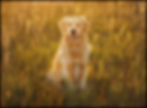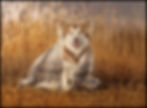Get Enlightened!
- Ginger Wick
- Feb 17
- 5 min read
I frequently get asked, “What’s the best time for a photo session?” And my immediate reaction is: “Now!”
🐾 You have a puppy? Perfect! Let’s photograph him now to capture all those tiny, sweet features that will look completely different all too soon.
⚽ You have a dog in its prime? Perfect! Let’s photograph him now to preserve all that prime-of-his-life energy and antics.
🥰 You have a senior? Perfect! Let’s schedule something now so you can always remember those details that make him him – the graying muzzle where you have kissed all the color away, his slower walk, his gentle demeanor.
After that answer quickly runs through my head, I realize folks are really asking about the time of day. 😉 The good news is that we have options! Let’s break them down:
Golden Hour
Most photographers (myself included!) will tell you “Golden Hour” is the best time for a session. This magical time of day, just after sunrise and about an hour before sunset, provides gorgeous, warm, and flattering light. Of course, here in Colorado, it’s more like “Golden Eight Minutes.” Ha! But even so, the light at that time of day is beautiful and warm, making it my preferred session time. Here’s why:
Backlit portraits: The sun behind the subject creates a dreamy glow.

Juliet and Eilah, backlit in fall afternoon light 
Bees Knees, backlit in warm morning light 
Ruth & Emily, backlit on a summer morning 
Queso, backlit in morning light Natural front/side light: Soft light from the front or side highlights natural textures.

Kita, side-lit 
Papi, front-lit near sunset Off-camera flash: This technique adds extra illumination for dramatic results.

Juno, backlit with additional light in front 
Biggie, backlit with additional light in front 
Ole, side-lit with additional light in front "Faking" golden hour: Since the warm look is so desirable, I've learned to replicate the golden hour glow using off-camera flash and colored gels - even after the sun has gone down, or on cloudy days.

Moose, the sun had already dipped below the horizon, but I wasn’t finished with this cutie, so I put a gelled strobe behind him to mimic the sun, and lit him from the front. 
Warrior, it was a totally overcast evening but I wanted a little warm glow, so placed a gelled strobe behind him and lit him from the front.
Blue Hour
The time just before sunrise and just after sunset is called “Blue Hour”. The sky takes on a deeper blue hue, creating a striking visual effect. I often use off-camera lighting to illuminate my subjects during this time.
Dramatic portraits: A unique aesthetic different from traditional golden hour.

Rue, blue hour, lit from the front 
Juliet & Eilah, blue hour, lit from the front Soft ambient light: Sometimes there’s enough remaining daylight for a stunning natural portrait.

Juno, natural light after the sun dipped down Silhouettes: Blue Hour is a fabulous time to create silhouettes, where your subject appears as a dark outline against a vibrant sky. Theoretically, silhouettes can be created any time the light source behind your subject is stronger than the light in front of it. However, at blue hour, you have the added benefit of richer sky colors that enhance the effect. A clean background, like an open sky, makes for the most striking silhouettes.

Amy & Toni, blue hour
Full Sun
Supposedly, midday is the least favorable time for photos due to harsh shadows, but I do love a challenge! 😝 With the right techniques, full sun can be used to great effect.
Overpowering the sun: Using flash to balance exposure.

Oakley, taken at high noon. Yes, there was some intermittent cloud cover, but the sun was poking out in full force during our session. I used my off camera strobe to “overpower the sun” and expose her properly. Side-lit drama: Positioning the sun to the side, coupled with a complementary pose, creates strong contrast.

Kenny, in full sun, positioned to the side with a striking result. 
Queso, full sun, positioned to the side. Had Queso been looking directly at the camera, the right side of his face would have been in shadow. Direct sun portraits: When properly positioned, the sun can enhance sharp, crisp images.

Mangus & Stigen, full direct sun, early morning 
Chama, full direct sun Daylight "night" look: Eliminating natural light for a dark, moody effect.

Remy. Perhaps surprisingly, this dramatic image was taken during daylight hours. I eliminated all existing natural light, and added my artificial light exactly where I wanted it.
Open Shade
If a session occurs during strong daylight hours, I often seek open shade - an area that has consistent shade, where the subject faces open sky to grab those much-desired catchlights in the eyes. Utilizing shade in this manner prevents the often squinty faces that occur in direct sunlight.
Urban shade: Using street shadows for soft lighting.

Raven, I used the buildings to block the light, and she faced the sunny side of the street Backyard shade: Utilizing home structures for shade.

Keegan, I used my house to block the light, and she faced the open sky behind me Architectural shade: Buildings provide the perfect “sun block”.

Kenny, while waiting for the sun to illuminate the stage “just so” in one of the previous examples above, I photographed him in the natural shade caused by a building 
Hawkeye, there were blue skies all around us, but the sun was still low enough that a wall provided great shade for Hawkeye. Many of the surroundings were white, so the light bounced back up onto him. 
Franklin. Not only did I use the building as a sunblock here, but I also used the landscaping grasses that were planted right next to it!
Overcast
Cloudy days are a dream! Soft, diffused light eliminates harsh shadows, creating a naturally flattering look. The muted color palette often results in some of my favorite images. (And many of them are of my own dogs, because they are the ones handy when the clouds roll in! 😝)
Soft, diffused light:

Kite, overcast (and cold!!) day 
Jemimah & Jack, roughhousing on a foggy California beach 
Queso, overcast 
Trestle, overcast 
Queso & Churro, overcast Adding flash for a pop: A little extra light enhances contrast in overcast settings.

Queso, overcast, lit from the front 
Queso & Churro, overcast, lit from the front – same bridge, different time of year!
Snow!
Snowy conditions can be magical! Falling flakes add texture – especially with a dark background, and the snow itself acts as a natural reflector, bouncing light beautifully back onto the subject. Plus, dogs love snow! ❄️
Winter wonderland portraits:

Queso 
Charlie 
Queso 
Mangus
Night
I don’t do a ton of true night photography (let’s be honest, it can be scary out there! 😉), but when I do, I embrace the darkness with creative lighting.
Urban night portraits: City lights create a dramatic atmosphere.

Queso, night 
Drift, night Lantern-lit moments: A touch of glow adds warmth.

Zambi, night Light painting: Long exposure techniques make for artistic effects.

Juliet & Eilah, night
Anything I Avoid??
There’s only one kind of light that has me running for the hills. Dappled light. Where patches of both sun AND shade intersect in a high-contrast pattern on my subject. Shudder. 😵💫 I have been known to use whatever’s on hand – people, a reflector – to cast shade in those circumstances, but honestly, I’d rather just avoid it if at all possible!
In Summary
There’s no bad time for a photo session! No matter the time of day, MAGIC can be made. Oftentimes, I’m able to mix and match the various techniques for multiple different looks in a single session. Which is your favorite? And, what are you waiting for? Let’s do it! 📸✨
Ginger Wick Photography is an award winning dog photographer specializing in creating beautiful custom artwork of dogs & their people. Based in Parker, CO serving the Denver area.
